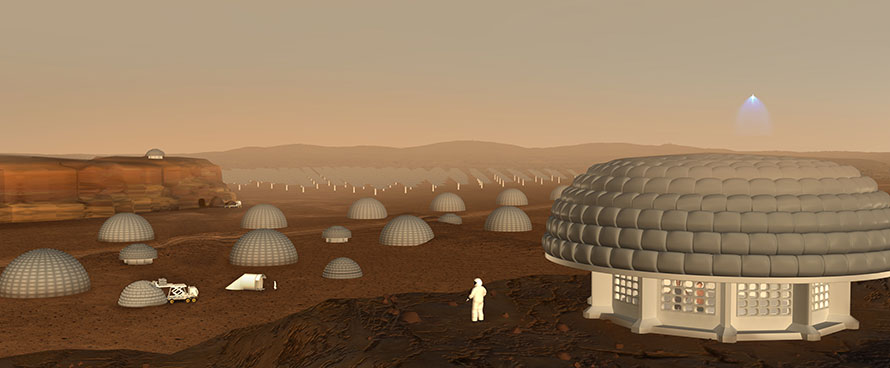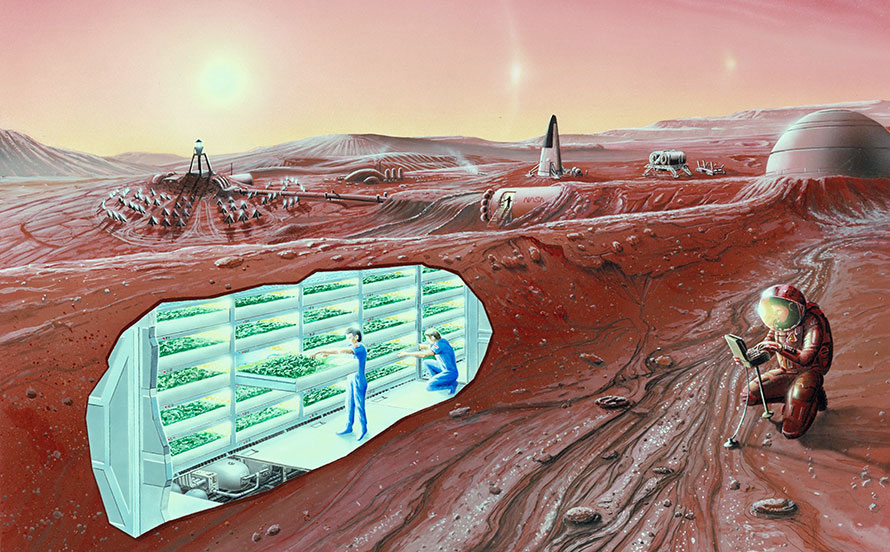The Martian base evolving into a permanent settlement, increasingly self-sufficient and increasingly focused on commercial activities.
 Early Mars city partially underground with shielded buildings and cupolas. Image: [email protected]
Early Mars city partially underground with shielded buildings and cupolas. Image: [email protected]
DESCRIPTION
The Martian base will continue to evolve, growing in volume, in area, in the number of habitat modules connected or nearby, and, especially, in population. At some point the decision will be made that the site is to be a permanent settlement if it has sufficient resources. The distinguishing characteristics of that settlement will include:
- people emigrating to Mars with no intention of ever returning to Earth,
- children being brought to Mars, and being born there,
- reasonable self-sufficiency having been demonstrated, including basic life support, stable food production, ability to construct additional habitation spaces from local materials with on-site equipment,
- a recognition that in case of emergency it will be impossible to evacuate the entire population and a willingness to bear that risk (as was the case on terrestrial frontiers), and, consequently, no requirement that enough vehicles be standing by for that purpose,
- enough habitat space to house all of the inhabitants in an emergency if part of the settlement is damaged.
- reasonably adequate medical and surgical facilities, comparable to a rural hospital on Earth.
- a “local” economy, with the inhabitants serving each other’s needs, as in small isolated villages on Earth,
- facilities for visitors, whether scientists, tourists, or others.
Whether humans and other mammals can survive and thrive for long periods of time, and reproduce and grow to adulthood successfully, in the one-third gravity of Mars remains to be determined, with or without advanced biomedical intervention.
As the cost of space transportation drops and the cost of the settlement is amortized or written off, emigrants from Earth should be able to pay all or at least part of the cost of their relocation. On Mars, commercial activities and experiments that were initiated in the base phase may be expanded, including tourism. Hotels may be among the structures added to the settlement. An increasing proportion of Martian settlers may be involved in such commercial activities.
It is anticipated that the majority of initial Mars settlements and buildings will be below ground so that the civilian population is not exposed to the surface radiation environment. Underground pedestrian and vehicular tunnels will probably connect most of the habitats in each community. Some buildings will be partly on the surface but will be shielded with Mars regolith generated by excavation. Some separate communities may be connected by subways. Psychological pressure for a view of the outdoors may result in the creation of above ground cupolas to allow anyone, even children, to see outdoors without significant radiation exposure.
 A primarily subsurface Mars settlement showing habitats covered by regolith, growing areas, industrial areas, energy production, surface airlocks, and utilities. Image: NASA
A primarily subsurface Mars settlement showing habitats covered by regolith, growing areas, industrial areas, energy production, surface airlocks, and utilities. Image: NASA
BARRIERS
- The lack of a developed and affordable commercial transport system to get large numbers of civilians to Mars with a sufficiently low radiation dose.
- The need to develop the ability to build pressurized structures from local Mars materials, such as steel from hematite, since millions of tons of habitats cannot be imported from Earth.
- The need to develop sufficiently large power sources on a world totally devoid of fossil fuels.
- Concerns about and lack of agreement on planetary protection protocols for human settlement on Mars.
COMPLETION
This milestone can be considered achieved when a growing settlement of at least 1000 adults has been there long enough for one generation to be born on Mars who in turn have had viable children.
MORE OF THE NSS ROADMAP TO SPACE SETTLEMENT:






